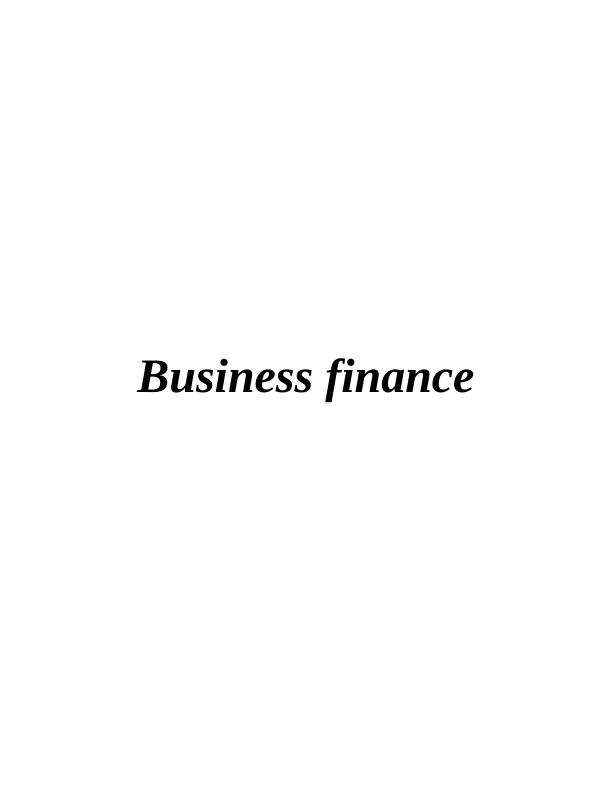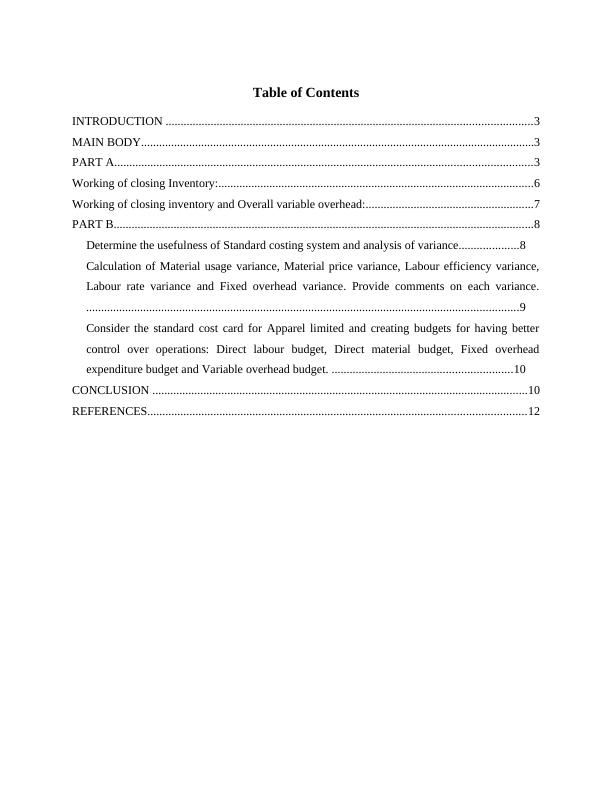Standard Costing System and Variance Analysis in Business Finance
Added on 2023-06-10
12 Pages3208 Words189 Views
Business finance

Table of Contents
INTRODUCTION ..........................................................................................................................3
MAIN BODY...................................................................................................................................3
PART A...........................................................................................................................................3
Working of closing Inventory:.........................................................................................................6
Working of closing inventory and Overall variable overhead:........................................................7
PART B............................................................................................................................................8
Determine the usefulness of Standard costing system and analysis of variance....................8
Calculation of Material usage variance, Material price variance, Labour efficiency variance,
Labour rate variance and Fixed overhead variance. Provide comments on each variance.
................................................................................................................................................9
Consider the standard cost card for Apparel limited and creating budgets for having better
control over operations: Direct labour budget, Direct material budget, Fixed overhead
expenditure budget and Variable overhead budget. ............................................................10
CONCLUSION .............................................................................................................................10
REFERENCES..............................................................................................................................12
INTRODUCTION ..........................................................................................................................3
MAIN BODY...................................................................................................................................3
PART A...........................................................................................................................................3
Working of closing Inventory:.........................................................................................................6
Working of closing inventory and Overall variable overhead:........................................................7
PART B............................................................................................................................................8
Determine the usefulness of Standard costing system and analysis of variance....................8
Calculation of Material usage variance, Material price variance, Labour efficiency variance,
Labour rate variance and Fixed overhead variance. Provide comments on each variance.
................................................................................................................................................9
Consider the standard cost card for Apparel limited and creating budgets for having better
control over operations: Direct labour budget, Direct material budget, Fixed overhead
expenditure budget and Variable overhead budget. ............................................................10
CONCLUSION .............................................................................................................................10
REFERENCES..............................................................................................................................12

INTRODUCTION
The case study discuss about the requirement of standard costing and how changes can be
analysed and assist in providing good outcomes towards the firm selection (Sharma and Chandel,
2021). It also consider in account based analysis that would assist in providing best outputs and
create sales revenue and profits also. It also helpful and give direction to the supervisors along
with the customers too and the requirement of budgets for estimating the performance being
provided. Apart from this it also considers in account how the resources are needed to be
maintain and utilization in dependent businesses and organization. It also describes the break
even measures, margin of safety and absorption costing which assist in knowing and providing a
complete view of its profitable and stability of the company.
PART A
Computation of contribution per unit:
This is the procedure which describe the profit with the regard of sale revenue of one unit
and decrease all expenditure variable on it and the value occurs is called as contribution (Johnsen
and Hvam, 2019). It is useful to determine how many products to be sold to recoup the relative
variable or fixed cost.
Contribution per unit = sales revenue per unit – variable expenditure per unit
= £120 – £50
= £70 per unit
The above calculation shows that sale revenue of per unit of company Lobelia is £120 and
variable cost is £50 per unit. The results came out after computation of contribution per unit is
£70.
Computation of break-even point and break-even sales:
The procedure of break-even analysis plays a important role to compute weights which
include expenses of firm and item against the selling price unit help to determine the position of
break even point (Paquibut and Al Naamany, 2020). Basically, Break even is the situation where
the level of sales and total amount of fixed expenditure and variable expenditure are on same
levels. It is the point where a company neither generate profit and loss.
The case study discuss about the requirement of standard costing and how changes can be
analysed and assist in providing good outcomes towards the firm selection (Sharma and Chandel,
2021). It also consider in account based analysis that would assist in providing best outputs and
create sales revenue and profits also. It also helpful and give direction to the supervisors along
with the customers too and the requirement of budgets for estimating the performance being
provided. Apart from this it also considers in account how the resources are needed to be
maintain and utilization in dependent businesses and organization. It also describes the break
even measures, margin of safety and absorption costing which assist in knowing and providing a
complete view of its profitable and stability of the company.
PART A
Computation of contribution per unit:
This is the procedure which describe the profit with the regard of sale revenue of one unit
and decrease all expenditure variable on it and the value occurs is called as contribution (Johnsen
and Hvam, 2019). It is useful to determine how many products to be sold to recoup the relative
variable or fixed cost.
Contribution per unit = sales revenue per unit – variable expenditure per unit
= £120 – £50
= £70 per unit
The above calculation shows that sale revenue of per unit of company Lobelia is £120 and
variable cost is £50 per unit. The results came out after computation of contribution per unit is
£70.
Computation of break-even point and break-even sales:
The procedure of break-even analysis plays a important role to compute weights which
include expenses of firm and item against the selling price unit help to determine the position of
break even point (Paquibut and Al Naamany, 2020). Basically, Break even is the situation where
the level of sales and total amount of fixed expenditure and variable expenditure are on same
levels. It is the point where a company neither generate profit and loss.

In the other words, It refers to the point where the revenue from sales cover the cost of
fixed as well as variable cost. Low level of sales shows low level of break even stage. Break-
even point describe the company's performance over a period of time.
Description of Break- even point:
Break-even stage is a expression of provisions (Kay, 2019).
lesser the sum of break-even, is favourable for its business.
The Computation of break-even point and break-even sales:
Break-even point = Fixed expense / (sales revenue per unit – variable expense per unit)
Break-even point = £700000 / (£120 - £50)
= £10000 units
In the above calculation break-even stage is measure in which fixed expenditure is divide
by the contribution per unit and the value of fixed expenditure is already given £700000 and the
amount of Contribution per unit is taken from above computation is £70.
Break- even sales in % = Fixed expense / Contribution margin
break- even sales = £700000 / £2800000 *100
= 25 %
As per above calculation the break-even sales of the Lobelia company is 25 % and if it
calculated in units then its express the equal unit of break even point.
Computation Margin of Safety as a percentage of budgeted sales:
The concept of margin of safety analyse the involvement between the level of sale and
the break-even sales of a company. It express the level of safety that a company communicate
before incurring the losses (Irfan and Ahmad, 2018). It decrease the level of break even point. It
is a investing principle which provide safety while market price is low that its intrinsic value.
Computation of Margin of safety:
Greater margin of safety is more favourable for the company.
Measuring margin of safety:
Margin of safety(MOS) = Budgeted sales of the firm – Break-even stage / budgeted sales * 100
= £40000 units - £10000 units / £40000 units *100
= £30000 units / £40000 units *100
= 75%
fixed as well as variable cost. Low level of sales shows low level of break even stage. Break-
even point describe the company's performance over a period of time.
Description of Break- even point:
Break-even stage is a expression of provisions (Kay, 2019).
lesser the sum of break-even, is favourable for its business.
The Computation of break-even point and break-even sales:
Break-even point = Fixed expense / (sales revenue per unit – variable expense per unit)
Break-even point = £700000 / (£120 - £50)
= £10000 units
In the above calculation break-even stage is measure in which fixed expenditure is divide
by the contribution per unit and the value of fixed expenditure is already given £700000 and the
amount of Contribution per unit is taken from above computation is £70.
Break- even sales in % = Fixed expense / Contribution margin
break- even sales = £700000 / £2800000 *100
= 25 %
As per above calculation the break-even sales of the Lobelia company is 25 % and if it
calculated in units then its express the equal unit of break even point.
Computation Margin of Safety as a percentage of budgeted sales:
The concept of margin of safety analyse the involvement between the level of sale and
the break-even sales of a company. It express the level of safety that a company communicate
before incurring the losses (Irfan and Ahmad, 2018). It decrease the level of break even point. It
is a investing principle which provide safety while market price is low that its intrinsic value.
Computation of Margin of safety:
Greater margin of safety is more favourable for the company.
Measuring margin of safety:
Margin of safety(MOS) = Budgeted sales of the firm – Break-even stage / budgeted sales * 100
= £40000 units - £10000 units / £40000 units *100
= £30000 units / £40000 units *100
= 75%

End of preview
Want to access all the pages? Upload your documents or become a member.
Related Documents
Business Finance: Cost Estimation and Investment Assessment Approacheslg...
|12
|2814
|301
Business Financelg...
|23
|5468
|265
Corporate Finance: Cost Estimating and Investment Assessment Methodologieslg...
|11
|2681
|456
Business Finance Case Study 1: Contribution, Break Even, Margin of Safety, Profit, Costing Methods, Variance Analysis, Budgetinglg...
|12
|2611
|161
Project Report on Manage Budget and Forecastlg...
|10
|2242
|52
Financial Budgeting and Analysislg...
|7
|1213
|86
